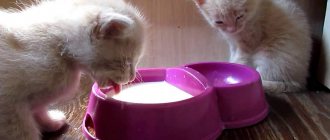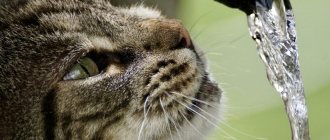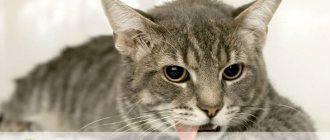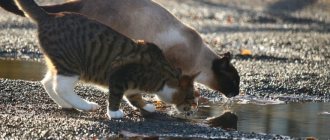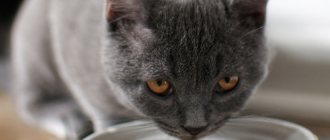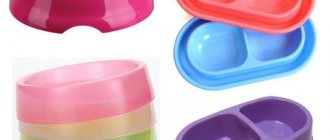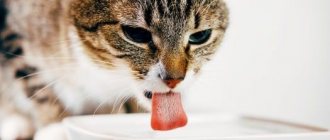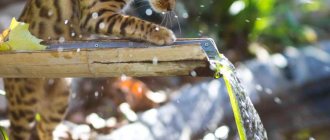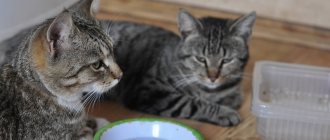Cats have a reputation for being hydrophobic. Most cats avoid getting wet as much as possible.
But some people like to play with their water bowls or look for additional sources of water in the environment.
The question is whether they do this because they are curious about water, or if they have a health problem that makes them drink a lot.
If you find your cat splashing around in a bowl of water rather than drinking it, it may have health problems.
The cat spills water from the bowl - the reason
Cats have a reputation for being hydrophobic.
Most cats avoid getting wet as much as possible. But some people like to play with their water bowls or look for additional sources of water in the environment.
The question is whether they do this because they are curious about water, or if they have a health problem that makes them drink a lot.
If you find your cat splashing around in a bowl of water rather than drinking it, it may have health problems.
Cats need wet food
Canned cat food helps your cat get the moisture it needs.
Because modern domestic cats are descended from desert-dwelling ancestors, they have little thirst. Compared to dogs, cats do not have an urgent need to find water. They will not, like dogs, look for any source of moisture just to quench their thirst. Because cats do not drink enough water and have very concentrated urine, they develop problems with their urinary system. Experts recommend preventing these problems by feeding your cat wet food periodically.
In the wild, cats eat prey such as mice, which are 70% water. Most wet food has a minimum of 75% moisture, while dry food has only 10% moisture. Therefore, wet food has two useful functions at once - it gives the cat the necessary nutrients and maintains fluid levels in the body.
Why do kittens splash in the water?
Kittens are generally playful and have a natural tendency to touch things with their paws. Maybe that's why they play with water. Cats groom themselves by licking their fur, so they are unlikely to use their bath water bowls. Kittens who play with water are most likely learning about the world around them in this way.
Some cats love water. There are breeds that are more tolerant of water (Maine Coons) than others. And if a young kitten is taught to take a bath, then as an adult he can be tolerant of water procedures.
There is debate about whether cats should be bathed and how often this should happen. Some cats like pond water and don't like to drink standing water in their bowls. They can play with water to recreate the effect of water ripples in natural settings.
Cat quirks related to drinking.
Many owners can talk about strange “rituals” that their pets perform around their cups.
Among the “strange” actions most often mentioned are the following:
In fact, their behavior looks strange only if you consider that they approach the saucer only to quench their thirst.
So what is the reason for these unusual actions around the drinking bowl?
Perhaps, it is unlikely that anyone will be able to give a short and accurate answer to this question. A person does not have the opportunity to simply ask the cat herself about the reasons for this behavior (more precisely, we can ask, but she will definitely not answer us). However, there are several hypotheses about why you need to touch the water, instead of just sticking out your tongue and starting to drink.
Perhaps the cat uses its paws to determine where the surface of the water is. Please note that the cat's eyes are located in such a way that the animal, leaning towards the saucer, does not see anything directly under the chin. Therefore, having previously felt the water with its paw, the cat tries to more accurately determine the distance between the tongue and its surface. This also explains why some cats tend to look at the water before drinking.
Some cats like to play with water. We tend to think that cats don't like water, but in fact, many of them love to play with and even in water. When looking for ways to have fun, cats, and especially kittens, may find that splashing liquid out of a cup and leaving their surroundings wet is a lot of fun!
As for "trampling" or scratching the floor near the saucer, this pattern of behavior is often associated with food utensils. Some experts believe that these are instinctive actions aimed at hiding food. Others see it as territorial behavior, an attempt to mark ownership of space around food sources. Probably, some of these assumptions are correct regarding the drinking bowl. This is all the more possible since owners often place food and drink bowls next to each other.
Health problems
Before you start working on behavioral problems, take your cat to the vet to make sure there is no medical reason for his behavior.
Diabetes, kidney failure and thyroid problems can make cats thirsty. They may drink from their water bowls more often and make a mess by splashing the water or scratching it with their paws if they are not feeling well.
They may also look for other sources of water, such as a faucet or toilet. Most cats with health problems also show other signs of illness, such as lethargy, confusion, or changes in appetite.
If you observe your kitten drinking excessive amounts of water or spending a lot of time focused on his water bowl, be sure to contact your veterinarian.
Anxiety or stress sometimes causes strange behavior in cats. The cat may put its paws in the water bowl or try to climb directly into the bowl. Separation anxiety often causes cats to seek attention from their owners by exhibiting abnormal behavior.
Sometimes this manifests itself as problems with litter boxes, marking objects, or defecating in the wrong place. For some cats, separation anxiety may cause them to splash around in the water bowl, push it to the side, or turn it over to get your attention.
Obsessive-compulsive disorder can also be aggravated by stress.
The dangers of insufficient fluid intake
If a cat doesn't drink enough, it becomes chronically dehydrated. First of all, owners notice problems with the coat - it becomes dull and falls out. Then the urinary system suffers. The urine becomes too concentrated and the salt crystals it contains precipitate. First, “sand” is formed, and then larger stones. Urolithiasis is especially dangerous for males - sand clogs the long and thin urethra, causing urinary retention.
Water is also important for digestion. Chronic dehydration causes constipation. If your pet's poop is hard as pebbles, this is a warning sign.
When dehydrated, your blood becomes thicker and your blood pressure rises. This is especially dangerous for cats with kidney or heart failure.
How to stop your cat from spilling water?
Sometimes a kitten playing in the water is just having fun. Some young cats love to be in contact with water, while others simply cannot stand it. Kittens tend to outgrow some behavior like splashing in water, so patience may be the best solution.
Play may be at its strongest for up to five months and begins to decline after that, so if the behavior does not begin to subside it may be helpful to turn his attention to other play items.
Elimination of stress and recommendations
Managing stressful situations can be difficult. If you can't pinpoint the problem, a board-certified veterinarian can help. He will give recommendations that are necessary to combat the problem.
In the meantime, try some tricks:
If you have a shower or bathtub, consider placing a bowl filled with water in it and showing it to your cat. You can increase your cat's interest with treats and praise. This way she can get used to playing with water bowls only inside the bathtub, where spills won't be a problem.
Change the water in the bowl frequently—at least once a day. You can add ice cubes to keep the water cold. But some cats may see these cubes as toys and will play with their water even more. Everything is individual.
Try alternative water containers. For example, such an option as a device for watering guinea pigs or other small animals.
Try using a fountain type water bowl with a continuous flow cycle to keep the water fresh.
Source
Why does a cat spill water from a bowl?
There is a myth that purrs are afraid of water. Many argue that this is already ingrained in them at the genetic level, because in most cases, careless owners get rid of unwanted offspring in a not entirely humane way. Blind kittens are drowned, although it is more optimal to sterilize the animal and no longer worry about where to put the cubs.
Because of the fear of water, it is difficult to bathe the animal. It begins to scratch and break out. However, if this procedure is still necessary because the pet is heavily soiled, it is important not to wet the ears, as this can cause them to become inflamed and painful.
Unlike dogs, purrs do not need to be bathed. They are very clean and very careful about hygiene. They have a keen sense of smell, like all predators, so they lick themselves at the slightest unpleasant odor. Mainly after eating and going to the toilet.
The placement of the bowls matters.
Does your cat also ignore water if it's near food?
Some cats will not drink if the bowl is too close to the food bowl. This is most likely due to the fact that in nature, cats try to eat as far away from the water source as possible to keep it clean from bacteria and other contaminants. Placing bowls side by side may cause food pieces to fall into the water. Cats also have a very strong sense of smell, and many cats don’t like to smell food when they drink.
Why can a cat spill water from a bowl?
Contrary to popular belief, many animals love to play with water. Some are even ready to get into the water and play. Animals are attracted to reflections on the surface. In addition, if you “touch” the water with your paw, strange circles appear that you need to catch.
A pet can spend a long time doing this activity. A significant disadvantage is the splashing of water throughout the room. And the wet animal will certainly run to dry on the master’s clean bed.
As a rule, those animals that were taught by a cat in childhood are afraid of water. However, if the cub was separated from its mother early, it may not be aware of the basic rules of behavior. Many purrs can even swim. There is a high chance of getting to it in your own bowl.
The owners of four-legged animals note that, after drinking, the animal begins to climb into the bowl, splash, and spill water all over the floor. Cats are very curious and intelligent creatures. These are some researchers, like little children who need to touch everything. Cats get into the water especially in the warm season.
Hiding a bowl of water to wean an animal is not an option. It is important to avoid dehydration. You just need to pour a little water and make sure that if your pet spills it, add it again. You can put the bowl in the bath to avoid discomfort with constant puddles in the place where you usually eat.
Don't worry about why your cat spills water from its bowl. A little time will pass and she will lose interest in this activity. It is better not to prohibit, as this way interest will be shown to a greater extent.
Tips for caring for cats, useful information on raising your pet, as well as other articles about cats.
Why does a cat pour water out of a bowl?
Instead of drinking, does your cat pour water from the bowl onto the floor? This is more than a prank or a whim - there are several reasons for this. You change your cat's water and discover that most of the contents of the bowl are on the floor. You start to wonder if you are feeding your pet properly as he tends to spill the water from his bowl. Is this a cause for concern? Why does a cat pour water out of a bowl?
But it's fun!
Although few cats enjoy bathing, many do love water. Spilling liquid from a bowl is a form of fun. When a cat gets bored, she finds new ways to liven up her drab day. Cats can spill water with their paws, throwing toys or food into the bowl, and even intentionally knocking over water bowls. Perhaps in this way the pet is trying to attract your attention and tell you that you are devoting too little time to it.
Is it so? That is the question!
Although cats have very good eyesight, they do not see very well at close range. For this reason, they may empty the bowl to see if the caregiver has done their duty and filled the bowl at all. Seeing the movement of water, the cat knows that there is water in the bowl.
Let's give the water some movement!
Many cats prefer running water. Cats living in the wild are guided by their instinct, which allows them to survive. He instructs them to look for fresh, clean, running water because it is less susceptible to bacterial growth than standing water. This is why your pet can throw water out of the bowl - he sets it in motion. For purrs who clearly prefer running water, a drinking fountain may be a good solution.
He can't drink from this!
Cat whiskers are very sensitive and react to even the slightest touch. Some murlakotams have such sensitive whiskers that drinking water from a bowl that is too small causes them significant discomfort. In this situation, in order to drink, the cat pours the contents of the bowl onto the floor. It is necessary to change the bowl to a wider one so as not to irritate the cat's whiskers.
Cat pours water out of bowl to feel safe while drinking
In homes with many cats, purrs may compete for a place to sleep or simply for a bowl of food and water. Less courageous and determined cats do not feel comfortable in the presence of other four-legged family members when their heads are bowed over a bowl - then they are more vulnerable to attack. If the bowl is against the wall and the animal is forced to turn its back towards the room, it may feel awkward.
Make sure each cat has its own water bowl. Be sure to install them in different places and at different heights.
Does your cat pour water out of the bowl? Why do you think she does this?
Source
Cat quirks related to drinking.
Many owners can talk about strange “rituals” that their pets perform around their cups.
Among the “strange” actions most often mentioned are the following:
In fact, their behavior looks strange only if you consider that they approach the saucer only to quench their thirst.
So what is the reason for these unusual actions around the drinking bowl?
Perhaps, it is unlikely that anyone will be able to give a short and accurate answer to this question. A person does not have the opportunity to simply ask the cat herself about the reasons for this behavior (more precisely, we can ask, but she will definitely not answer us). However, there are several hypotheses about why you need to touch the water, instead of just sticking out your tongue and starting to drink.
Perhaps the cat uses its paws to determine where the surface of the water is. Please note that the cat's eyes are located in such a way that the animal, leaning towards the saucer, does not see anything directly under the chin. Therefore, having previously felt the water with its paw, the cat tries to more accurately determine the distance between the tongue and its surface. This also explains why some cats tend to look at the water before drinking.
Some cats like to play with water. We tend to think that cats don't like water, but in fact, many of them love to play with and even in water. When looking for ways to have fun, cats, and especially kittens, may find that splashing liquid out of a cup and leaving their surroundings wet is a lot of fun!
As for "trampling" or scratching the floor near the saucer, this pattern of behavior is often associated with food utensils. Some experts believe that these are instinctive actions aimed at hiding food. Others see it as territorial behavior, an attempt to mark ownership of space around food sources. Probably, some of these assumptions are correct regarding the drinking bowl. This is all the more possible since owners often place food and drink bowls next to each other.
